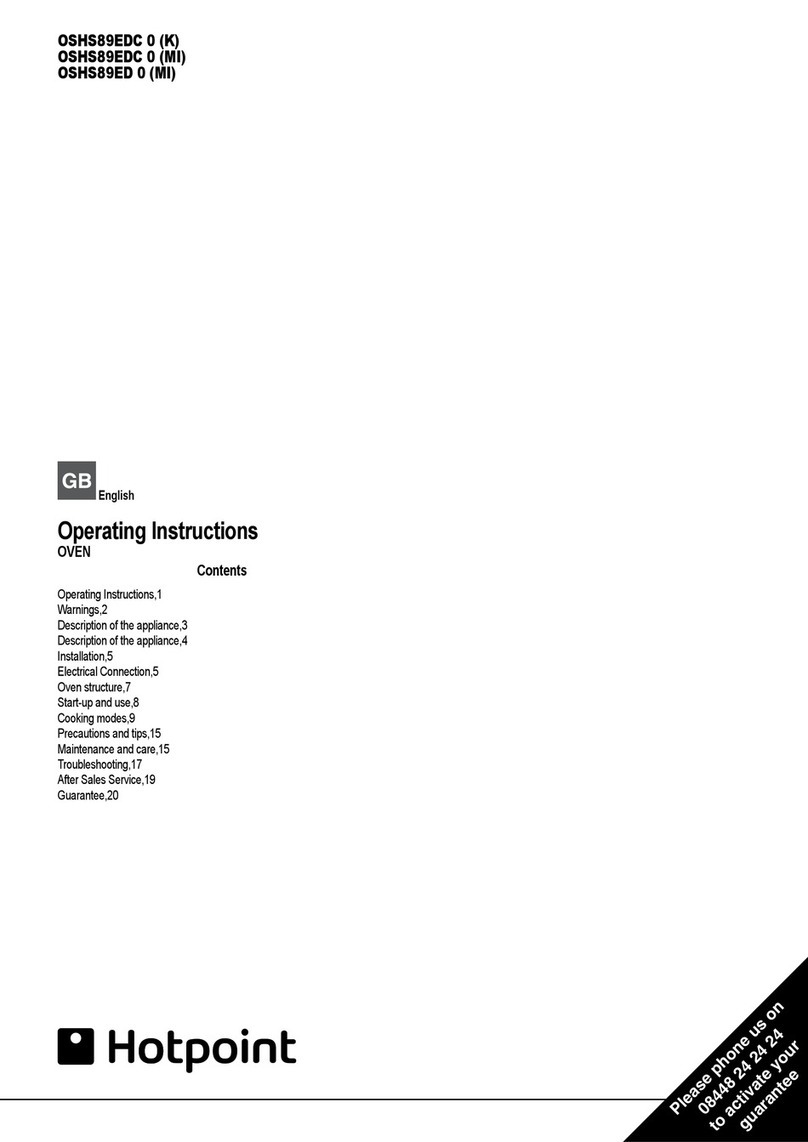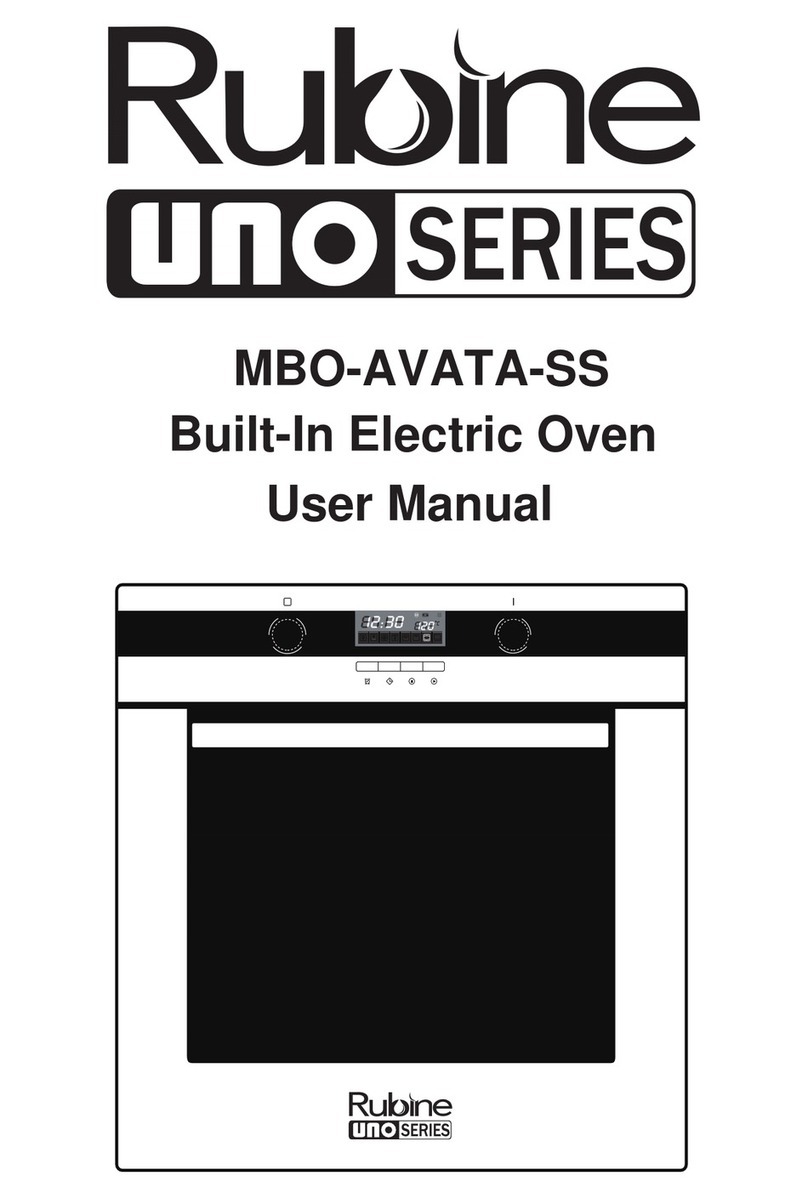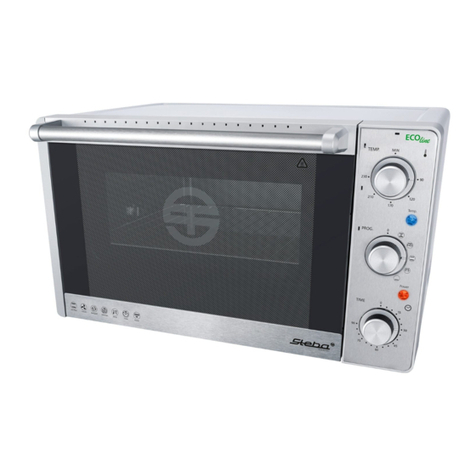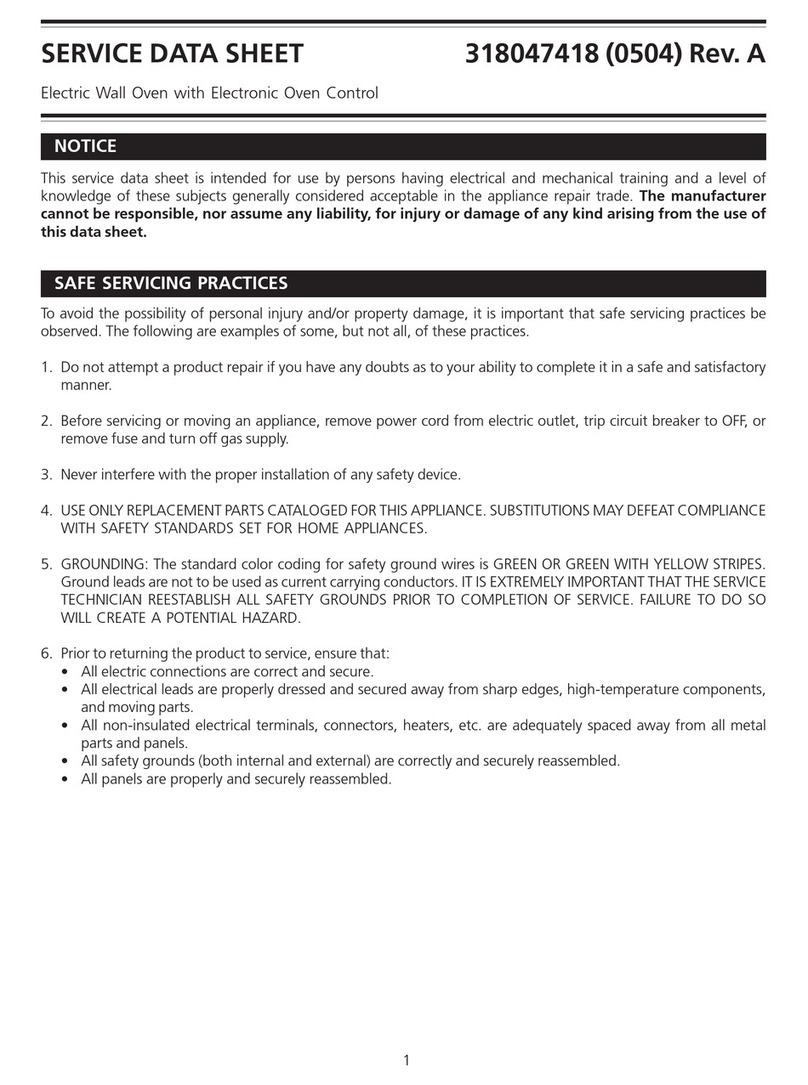Thermcraft LBO-24-10-10-1T-J14642/1A User manual

APPRECIATES YOUR BUSINESS
We thank you for purchasing a Thermcraft, Inc. heat treating oven. Since
our establishment in 1971, Thermcraft, Inc. has manufactured reliable, high
quality, electric resistance and gas equipment. Our products are used in a variety
of applications both domestically and around the world.
For over 40 years, Thermcraft, Inc. has manufactured ovens and ovens to
comply with predetermined custom and industrial specifications. This oven has
been completely checked for mechanical and electrical compliance prior to
shipment.
We trust you have received your oven in acceptable condition and that
you will find it meets or exceeds your expectations and requirements.
Prior to installation and operation of your new Thermcraft, Inc. oven, we
strongly urge you to read this manual it its entirety and comply with all
instructions herein.
If you have any questions, feel free to contact us.
Made in the U.S.A
Sincerely,
Thermcraft, Inc.
3950 Overdale Road
Winston-Salem, NC 27117-2037, U.S.A.
Telephone (336) 784-4800
Fax (336) 784-0634
Web: www.thermcraftinc.com
100-340-726 A

THERMCRAFT, INC.
INSTRUCTION MANUAL
CONTENTS
1. Oven Specifications
2. Inspection and Damaged Instructions
3. Accessories
4. Assembly
5. Control Environmental Conditions
6. Installation and Power Connection
7. Operational Safety
8. General Information
9. Preventative Maintenance
10. Thermocouple
11. Enabling Cooling
12. Replacement Parts List
13. Oven Trouble-Shooting
14. MSDS sheet
15. Control System Operation
16. Standard Configuration
17. Over-temperature Controller Operation (if applicable)
18. Oven Assembly Drawing (see included files)
19. Electrical Specifications (see included files)
20. Electrical Wiring Diagram (see included files)
21. Controller Manual (see included files)

1.) OVEN SPECIFICATIONS
Oven Type:
Model #: LBO-24-10-10-1T-J14642/1A
Serial #:
Weight: 350 LBS
Maximum Temperature: -150°C to +350°C
Heater Type: Inconel covered air heaters
Cooling: Liquid Nitrogen
Incoming Power:
Volts 208/230
Amps 20
Watts 3000
Phase 1
Hertz 50/60
Control System:
Model #: 1-1-30-230-E06ST-J5929_7EA
Temperature Controller Type and Model: EUROTHERM 2408/CP/VH/LH/TC
Power Requirement:
Volts: 230
Amps: 30
Plug: INTERPOWER 87520051
Receptacle: INTERPOWER 84232203
Cord: INCLUDED WITH PLUG
Thermocouple Type: T

2.) INSPECTION AND DAMAGED INSTRUCTIONS
INSPECTION
Upon receipt of your new oven, inspect for visible exterior damage. Note
and describe any damage found on the freight bill and file a claim with the carrier.
Once unpacked, carefully inspect for concealed loss or damage on the
unit itself, both the interior and exterior. If necessary, the carrier will arrange for
official inspection to substantiate your claim.
Verify that all of the equipment shown on the packing slip is included with
the unit. Carefully check all packing materials.
RETURN SHIPMENT
Save the shipping box/crate until you are sure all is well. If for any reason
you must return the unit, first contact our Sales Department at 336-784-4800.
Please have the unit’s serial number and model number available when you call
(located on the rating plate). Note: all returns MUST have a Return Authorization
Number.

3.) ACCESSORIES / OPTIONS PURCHASED
_X_ YES ___ NO LOAD PORTS QTY _2_
_X_ YES ___ NO VIEWPORT QTY _1_
_X_ YES ___ NO CRYOGENIC GAS INJECTOR QTY _2_
_X_ YES ___ NO EXHAUST PORT QTY _1_
_X_ YES ___ NO DOOR INTERLOCK SAFETY
___ YES _X_ NO HAND PORT
___ YES _X_ NO PORTABLE OVEN DOLLY
_X_ YES ___ NO OVER-TEMP. CONTROL SYSTEM
___ YES _X_ NO TEMPERATURE RECORDER

4.) ASSEMBLY
The oven will arrive pre-assembled; however, some assembly may be
required prior to start-up.
NOTE: These ovens are heavy and care should be taken to use lifting
devices which are sufficiently rated for these loads. Doors, handles and knobs
are not adequate for lifting or stabilization. The unit should be completely
restrained to prevent tipping during lifting and transport.
For larger ovens some parts such as doors, door tracks, car bottom
tracks, elevator lifts, blower motors, and conveyors may have been disassembled
from the oven to accommodate shipping. Before proceeding with installation,
review all of drawings and diagrams included in this manual.
1. Refer to designs, making sure all oven stands, control boxes,
terminal boxes, doors, etc., are in place and secure. If not, locate
the appropriate parts that are included in the shipment and follow
the oven design drawings in order to complete the assembly.
2. Locate the thermocouple hole and carefully pull out the alignment
pin. Carefully slide thermocouple into the hole, do not force.
If any questions arise concerning assembly of the oven, please contact
Thermcraft, Inc. at 336-784-4800.

5.) CONTROL ENVIRONMENTAL CONDITIONS
Normal Operating Conditions
1. Ambient temperature: 0 – 50°C
2. Rate of change in temperature: 10°C/h or less
3. Ambient humidity: 20-90% RH (no condensation allowed)
4. Altitude: 2000m or less above sea level
Maximum Effects from Operating Conditions
1) Temperature effects
1.1. Thermocouple, DC mV and DC V input: +/- 2u V/°C or +/-0.02% of
F.S/°C, whichever is the larger
1.2. Resistance temperature detector: +/-0.05°C/°C
2) Effect from fluctuation of power supply voltage (within rated voltage range)
2.1. Analog input: +/- 0.2u V/V or +/-0.002% of F.S/V, whichever is the
larger
Transportation and Storage Conditions
1) Temperature: -25 to 70°C
2) Humidity: 5 to 95% RH (no condensation allowed)

6.) INSTALLATION AND POWER CONNECTION
After the above assembly procedures have been completed, the oven is
ready for connection to incoming power as follows:
1. Open the oven and remove the protective packing covering the
heating elements.
2. Consult an electrical professional and the NEC (National Electric
Code) specifications to select wire size to adequately carry the line
amperage shown in section 1.) Oven Specifications: Connect
electrical service to a fused power source disconnect. Such
disconnect device shall be marked as a disconnect device for the
oven.
3. For overcurrent protection device selection, please refer to
amperage shown on the oven rating plate.
NOTE: Be sure to check all external strain relief fittings for tightness. See
Torque Recommendation for Strain Relief Fittings chart below:
TORQUE RECOMMENDATIONS FOR STR
A
IN RELIEF FITTINGS
Torque in Inch Pounds - in lb (Newton Meters - Nm)
METAL STRAIN RELIEF FITTINGS PLASTIC STRAIN RELIEF FITTINGS
DOME NUTS THREAD AND LOCK
NUTS DOME NUTS THREAD AND LOCK
NUTS
PG 7, M12x1.5 36.9 (4.17) 55.3 (6.25) 14.4 (1.62) 22.1 (2.50)
PG 9, PG 11, M16, PG 13.5, 3/8" NPT, 1/2"
NPT, M16x1.5, M20x1.5 36.9 (4.17) 55.3 (6.25) 22.1 (2.50) 33.2 (3.75)
PG 16, 1/2"NPT-E 44.2 (5.00) 66.4 (7.50) 29.5 (3.33) 44.2 (5.00)
PG 21, PG 29, PG 36, PG 42, PG 48,
3/4"NPT, 1"NPT, 1-1/4"NPT, 1-1/2"NPT,
M25x1.5, M32x1.5, M40x1.5, M50x1.5,
M63x1.5
59.0 (6.67) 88.5 (10.00) 44.2 (5.00) 66.4 (7.50)
Note: The values shown above are for reference only.
Note: Nylon strain relief fittings installed in a threaded connection and exposed to elevated temperature
should be retained with a sealant such as Locktite® to avoid a loose connection when temperature
fluctuates.

7.) OPERATIONAL SAFETY
.
Safe operation of your new oven is mandatory. As manufacturer of your oven, we at Thermcraft,
Inc. have adhered to all known safety standards and strongly suggest you install your oven in
accordance with national electric and fire protection codes. Do not exceed the electrical and
temperature rating printed on the oven rating plate.
It is important to pay particular attention to those regulations that are applicable to the
specific governing operations entities including, but not limited to legislated and accredited
national and local industry standards and the type of facility in which the oven will be employed,
including zoning requirements, local building codes, and local electrical codes.
SYMBOLS USED ON THE EQUIPMENT
Caution: risk of electric shock. Caution: hot surface.
Caution: refer to accompanying documents.
The potential for electric shock is always present when electrically operated equipment is
in use. The following suggestions are recommended for your protection:
1. Before beginning service / maintenance procedures on your oven, the power source must
be locked out and tagged out per Occupational Safety and Health Administration (OSHA)
regulations.
2. Insure the oven is properly grounded and electrically protected. Grounding lugs and
ground wires have been installed prior to shipment. The ground wire will terminate within
the external terminal box and is visible to the installer / operator. If unsure of the
grounding status of the equipment, consult the NEC (National Electric Code) or a
licensed professional.
3. If electrically conductive material is to be heat treated, the operator must be protected
from becoming a conductor to the ground. To avoid electric shock observe the following
operating practices:
a. Wear insulated gloves specific to the task that guard against electric shock if the
operator will be in contact with an electric current.
b. When using any metallic instrument to introduce items into the oven, insure the
handle is properly insulated and the instrument is adequately grounded.
c. Install rubber mats in front of and behind the equipment to protect the operator.
CAUTION: If this equipment is used in a manner other than described in this
manual, protection provided by the equipment may be compromised or impaired.
To preclude hazard and minimize risk, follow all instructions and operate within
the design limits noted on the rating plate.
Do not use components or materials not specifically designed for this equipment.
Failure to comply with this precaution could result in damage to the equipment
used or the oven and may create an overheat situation. Also, do not use anything
other than OEM exact replacement parts. Not using OEM replacement parts
could cause faulty instrumentation readings, inoperative equipment, or a
temperature overshoot.
Avoid combustible product which generate toxic or hazardous vapor or fumes.
Work should be done in a properly vented environment.
Observe the following precautions:

* Never stand in front of an open hot oven.
* Wear protective eyewear.
* Wear protective gloves.
WARNING: Do not use combustible gases directly in this oven. Process
gasses must always be contained in a separate tube.
Modification of equipment for use other than that for which it is explicitly designed
for could cause severe injury or death. Any customer after market retrofit violates
the warranty.
Do not modify or disconnect any safety features provided. Disconnection of the
units safety features could allow the unit to become overheated and start on fire,
causing personal injury or death, product and property damage.
Periodically disconnect power from the equipment and allow it to cool completely. Once
cool, inspect for loose or broken heaters and for worn wire coils on the inside of the heated
chamber. Heaters may have to be replaced if damage is severe. Avoid contact with any
exposed heater coils / elements. Do not touch elements with bare hands or oily gloves. Contact
Thermcraft, Inc. if unsure of the safety of the heating elements in the conditions you have
observed.
Only qualified electrical professionals should remove the upper and lower terminal covers
of the terminal boxes. Keep all guards (guide-tabs, backstops, upper and lower terminal covers)
provided with the equipment in place while the oven is in operation. Observe all safety labels.
If questions arise concerning the operation of your oven, contact Thermcraft, Inc. at (336) 784-

8.) GENERAL INFORMATION FOR TEST FRAME OVENS
CAUTION! Failure to check thermocouple wiring and connection before
initial start up could result in damage to the oven.
INSPECTION
Carefully inspect the oven upon its arrival for possible damage incurred during shipment.
If damage is evident, immediately notify the carrier and file a claim.
Do not discard any shipping packages until you are sure all components are accounted
for.
Most options will be attached to or are part of the oven itself. The solenoid valves are
located within the rear cover. The main items not attached to the oven are the port plugs
and mounting shaft collars, if purchased.
DESCRIPTION
The oven's function is to heat and/or cool samples. Please review the Oven-Test
Chamber Specifications page for your oven's limitations.
HEATING
Heat is provided by tubular heating elements located at the rear of the plenum. Air is
recirculated over the elements to generate heat.
COOLING
Cooling is provided by injecting liquid N2 or C02 thru the rear of the oven. (See the
Oven - Test Chamber Specifications page to see which specific option is being used.)
The cold gas is mixed with the recirculating air.
POWER REQUIREMENTS
Refer to the Oven - Test Chamber Specifications page for details.
SENSOR
A thermocouple sensor has been provided with the oven. The final positioning is
covered further in this section under Control Thermocouple Positioning. Other
thermocouple types are also available and can be easily installed.
INSTALLATION
After completing any minor assembly procedures, the oven is ready for connection to
your services. Install as follows:
1. Remove any packing from the interior of the oven.
2. NOTE: The oven has already gone through a partial bake out procedure required
for the mineral wool insulation. This partial bake out is done during quality
control testing and causes discoloration of the inside liner. The discoloration
does not affect the oven's performance. Some smoke or moisture may be
emitted by the oven during the initial burn in. Please ensure that ventilation is
provided to prevent excessive build-up in the test area.

MOUNTING
All ovens are supplied with slide mounting brackets. Before moving the oven, make
sure the locking pins are engaged to prevent the slides from moving.
The oven should only be moved via an overhead crane or fork truck using the supplied
eyebolts on the top of the oven. Position the oven between the slide mounting brackets
and align the front two holes in the slide assembly over the tapped holes in the test
frame.
CAUTION: Do not block the perforated areas on the rear cover. Cooling is required for
the electronics and the blower motor.
ELECTRICAL WIRING CONNECTIONS
The control system has been connected to the chamber before shipment. A conduit
feed through has been provided on the lower feed through panel to allow the wiring to
remain in place when removing the rear cover. The feed through panel can be removed
if necessary. Any conduit provided shall be permanently secured / mounted during
installation. Please make sure that any additional wiring meets all local electrical codes.
NOTE: The control system is supplied with a power cord and plug. Refer to the Oven-
Test Chamber Specifications page for a description of the cord and plug. Ovens shipping
to Europe will also include a matching IEC receptacle.
NOTE: The oven door has a safety interlock switch. The door must be closed for the
oven to operate. This feature was designed to protect the operator from hot or cold air
blowing directly on them while accessing the oven.
THERMOCOUPLE
The thermocouple measures the voltage that is generated as the temperature increases.
A current will flow providing an input signal for the control system to monitor and provide
operational control.
The tip of the thermocouple must be in the heated chamber and not covered or shielded
to the point where it cannot sense the actual temperature.
If the temperature controller displays the message "S.br" (sensor break), the
thermocouple circuit is faulty. A loose connection, broken wire or burned out
thermocouple could be the
cause.
When replacing thermocouples, remember to use the same type thermocouple.
Extension wires and connectors must also be compatible with the thermocouple and
controller. Be sure to observe correct polarity of thermocouple extension wire. Red leg
is always negative for thermocouples.
NOTE: The thermocouple has not been calibrated unless specifically ordered as such.
Upon request, calibration will be preformed on the thermocouple and a calibration report
will be enclosed in the appendix.

OPERATION
The conduit is permanently secured and the rear cover installed, apply power to the
control system to test the oven's components. Then run the oven up to 200F to verify
proper operation.
CAUTION: Do not run up to maximum operating temperature until the control
thermocouple has been positioned properly. Its current location may allow the oven to
exceed operating range and cause damage to the elements, the load train and/or your
specimen.
OPERATING CONTROLS
1. The main circuit breaker is located at the rear of the control cabinet. When the
circuit breaker is in the off position, all power is removed from the oven. The
control cabinet should not be positioned such that it is difficult to operate the
disconnecting device.
2. The control power switch is located on the front of the control cabinet. This
switch must be in the on position for the oven to operate.
3. The light switch is located on the front of the control cabinet and is used to
control the interior light.
4. The reset switch is located on the front of the control cabinet. It is used to reset
the high limit controller should the chamber temperature exceed the limit setting.
5. The high limit controller is located on the front of the control cabinet and is used
to protect the chamber from excess temperature. The high limit backs up the
main temperature controller. If the set point is exceeded, an alarm message will
be flashed on the display. After the temperature has returned to normal, push
the reset switch.
CONTROL THERMOCOUPLE POSITIONING
The final position of the control thermocouple is determined by your requirements. This
may be determined by a trial and error process. It is recommended to have an
additional thermocouple and recorder for the test. A flexible thermocouple has been
provided for the control sensor.
1. Position the monitoring thermocouple on the specimen or in the air near the
specimen. Thermocouple response time is dependent on the location and load.
2. Position the control thermocouple in the air exhaust, mark this location A. This
will provide the slowest response in the system and the specimen may never see
the control temperature. This initial test will ensure that the exhaust temperature
will never be above the maximum for the oven.
3. If the specimen does not reach operating temperature, save the information.
Now reposition the control thermocouple between the exhaust and inlet, mark
this one B.
4. Conduct the test again and compare the results with the first run. If the specimen
reached temperature and the tuning for the controller is satisfactory, you may
either stop or reposition the thermocouple at another location of your choice to
see if any further improvement can be made.
You may have to repeat the test several times before the results meet your
specifications. It is difficult to position the control thermocouple at the factory due to the
limited information on the exact load being used.

AIR FLOW PATTERN
An Oven Air Flow Pattern drawing for this oven is included in this manual. The exhaust
is top and bottom with the inlet in the middle. The main plenum protects the working
chamber from direct radiation from the heating elements. The secondary plenum adds
turbulence and prevents the air from directly recirculating. The secondary plenum also
protects the operator from coming in direct contact with the blower wheel.
Air uniformity will be affected by large specimens and/or load trains. The amount of air
reaching the front of the oven will be reduced by larger specimens. CAUTION: Do not
block the air flow inlet or exhaust. This will restrict air flow and affect the uniformity of
the oven and may damage the elements.
COOLING OPTION
1. C02 systems have a single injector assembly. An extra injector assembly will be
present at the bottom if conversion to LN2 medium is required. The solenoid
valve provided will be set up for either 300 or 1000 psi service per your order. A
1/4" compression fitting is provided for your connection. This can be found on
the rear feed through panel.
2. LN2 systems have dual injectors plumbed from one solenoid valve. The dual
injectors allow the lower pressured LN2 to be distributed evenly. Normal supply
pressure from a 160 liter liquid exceller tank is approximately 25 psi.
VENTILATION
It is IMPORTANT to have adequate ventilation when using C02 or LN2.
A vent hood may be necessary.
SHUT DOWN PROCEDURES FOR OVENS WITH COOL DOWN BLOWERS:
CAUTION! Do not shut the blower off until the oven has cooled down.
Change to the controller set point down to 100° F. Allow the oven to cool down to
100° F then switch the power button to the off position.
For conducting service work, follow your companies log out/ tag out procedure.

AIR BAFFLE
CHANNELS AIR FLOW
REAR COVER
AREA
INJECTOR
HEATER
ELEMENT
BLOWER
MOTOR
BLOWER
WHEEL
FEED THROUGH
LIGHT
(IF REQUIRED)
ALL PLUMBING & ELECTRICAL
ENTER @ FEED THROUGH NOTE: AIR FLOW FOR
CONVENTIONAL OVEN IN
TYPICAL MOUNTING POSITION
OVEN
PORT (ON CENTER LINE)
DOOR SEAL
FLOW LINES
FLOW LINES
C
E
N
T
E
R
L
I
N
E

9.) PREVENTIVE MAINTENANCE
CAUTION: Maintenance should only be performed by trained personnel.
WARNING: Prior to performing maintenance to the oven or the controls,
the main power must be disconnected. Prior to maintaining this
equipment, read the applicable MSDS at the back of the manual.
General Oven Maintenance LIGHT
1. Inspect and verify all electrical connections for tightness. Due to thermal
expansion during the heat- up/cool-down cycles electrical connection may
become loosened.
2. Inspect the heating elements. Do not allow build up of foreign material on
the element. Oil should be cleaned off of any part of the oven prior to
heating. Use caution not to displace the heating elements as the wire may
be brittle and break easily.
3. If oven has a door, verify that the door safety switch is operating and
cutting the power to the heaters once the door is opened.
4. Check all hardware fasteners to ensure that they are tight.
5. Inspect the tip of the thermocouple for excessive heat deterioration.
General Control Cabinet Maintenance
1. Verify that all electrical connections are tight.
2. If applicable, clean the cabinet cooling fan filter.
3. Check all cabinet to oven interconnection wiring.
4. If applicable, check to ensure that all signal lamps light.
REPLACEMENT PARTS
It is recommended that you obtain replacement parts from Thermcraft Inc. to insure that
system safeguards are not compromised. Variations in component specifications could
cause the equipment to be unsafe.
ELEMENTS HEATING
The elements should last more than three (3) years unless overheated due to restricted
air flow or a malfunction of the control system. No other maintenance is required.

FUSE REPLACEMENT
Replace fuses with the same size and type as supplied.
1FU - Bussmann FNQ-R-3Y> (3.5 A, 600 V Dual element time delay fuse)
2FU, 3FU - Bussmann FNQ-R-1 (1 A, 600 V Dual element time delay fuse)
4FU - Bussmann FNM-1 Y. (1.25 A, 250 V Dual element time delay fuse)
PORT PLUG MACHINING OPTION
Port plugs can be purchased with or without a bore. If purchased without a bore, the
following steps may help you with machining them to fit your needs:
1. Plugs will be sent whole and cut to specified holes, solid plugs with have a ¼”
hole for custom drilling. Make sure you use a wood backing to drill into as this will
prevent breakage of the plug. For smaller holes, use a regular drill bit. It may dull
faster if you are drilling multiple holes. For large holes, purchase a hole saw with
the correct size for your requirements.
2. With the correct size hole saw, place the port plug in a drill press or drill. Drill into
the plug keeping a vacuum sweeper handy to collect the dust and pieces. A
normal hole saw does not have the depth required for a 2" thick piece. It may
require you to flip the piece over and continue drilling. Discard center pieces and
check for fit.
INTERNAL OVEN CHAMBER LIGHT (OPTIONAL)
The current light cannot be operated above 600 Deg. F (315 Deg. C). If you are
planning to conduct testing above 600 Deg. F, you must remove the light bulb and
replace it with the insulation plug provided. If your oven was not rated for operation
above 600 Deg. F, then no insulation plug was provided. Operation above 600 Deg. F
with the light bulb in place will cause early failure of the bulb and perhaps cause the bulb
to explode.
SLIDE ASSEMBLY MOUNTING BRACKETS OPTION
This option allows the oven to slide backwards out of the test frame. This exposes the
oven's working area for ambient testing when needed. The locking pins on the side hold
the oven in the forward position.

10.) THERMOCOUPLE
A thermocouple is used to measure the voltage that is generated as the
temperature increases. It provides an input signal for the control system that
monitors the temperature of the heated chamber.
At high temperatures, the elements within the thermocouple may undergo
some oxidation or corrosion causing the signals to be read incorrectly by the
control system.
If possible, the tip of the thermocouple must be at least 1/8 deep. Also, the
thermocouple tip must not contact items being heat treated.
If the control system indicates that a thermocouple is no longer
functioning, it is important to replace the malfunctioning thermocouple with the
same type model thermocouple that was originally provided with the oven.
Replacement extension wires and connectors must also be compatible with the
thermocouple and the controller. If your system has a Eurotherm controller a
failed thermocouple will be indicated by SBR on the display and for a Yokogawa
controller it will indicate B.OUT. Refer to the replacement parts list to determine
the type of thermocouple required.
NOTE: Polarity of the thermocouple extension wires is the
OPPOSITE of the polarity of typical electrical wiring. The red leg is always
negative for thermocouples while the black leg is always positive.

11.) ENABLING THE COOLING FUNCTION
Thermcraft, Inc. does not enable the cooling function of your oven prior to
shipment.
Following are instructions to do so.
To enable output 2A, access the configuration mode.
Put in code, if any. Default is 2.
Using the page down button, select parameter 2A.
Make the following selections:
10 :SSR
Func: Cool
Val-I: 0
Val-h: 100
Out-I: 0
Out-h: 100
Return to the main menu
Using the page button, select Access
Select Full
Using Page Button, select OP
Set Output low = -100
Set Output high = +100
SPL(-328)

12.) REPLACEMENT PARTS LIST
Description Item # Quantity Included
HEATER ELEMENT A-7506 4
THERMOCOUPLE A-7502 1
FAN MOTOR FUSE F1 1
CONTROL TRANS
PRIMARY FUSE F2 – 3 2
CONTROL TRANS
SECONDARY FUSE F4 1
LN2 CONNECTION 850635K459 1
Table of contents
Popular Oven manuals by other brands
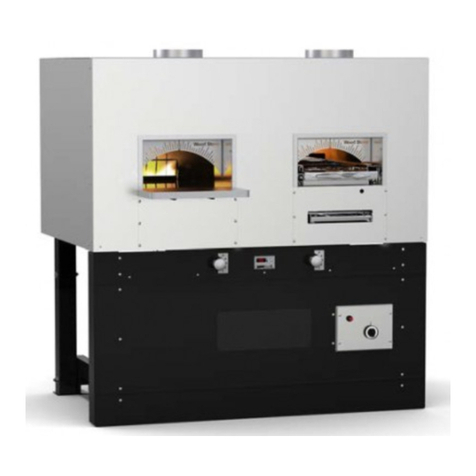
Wood Stone
Wood Stone 4048 Installation and operation manual

montpellier
montpellier MON-SFO59LED Installation and operating instructions
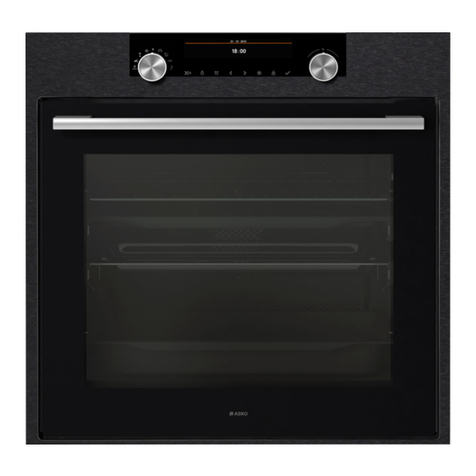
Asko
Asko OT8687S Instructions for use

Euro Appliances
Euro Appliances MILAN EMEO60SX manual
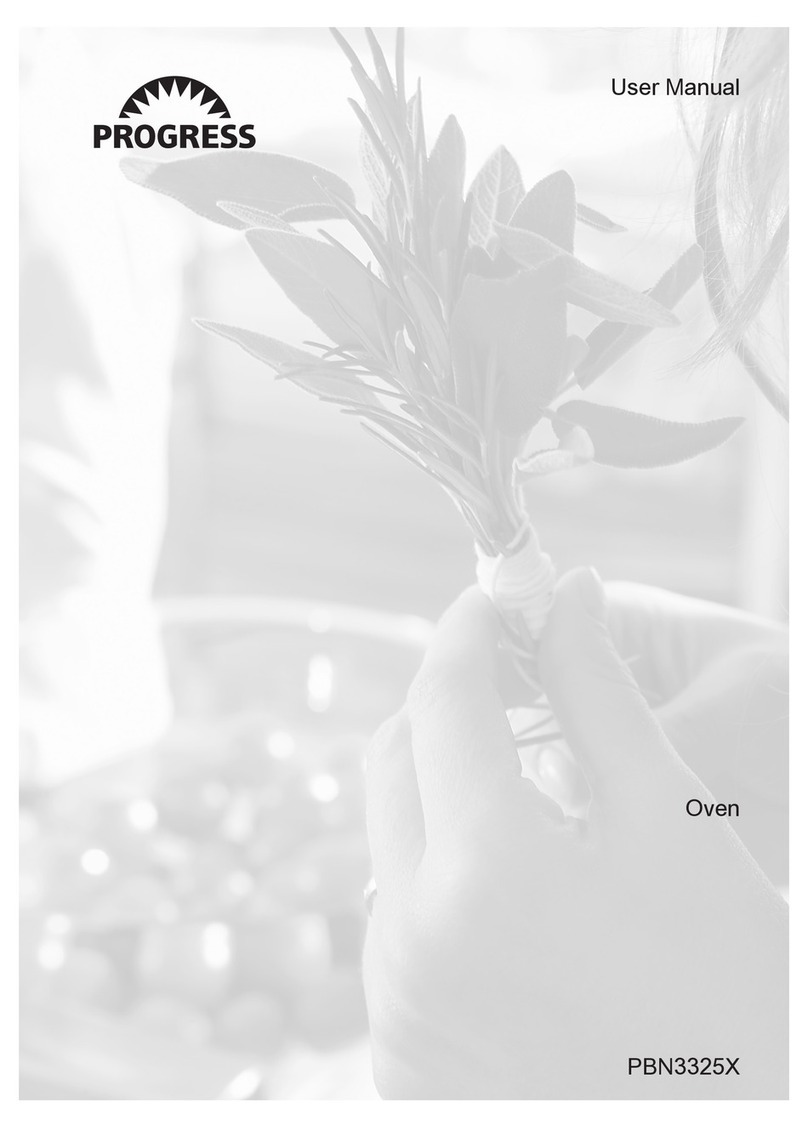
Progress
Progress PBN3325X user manual
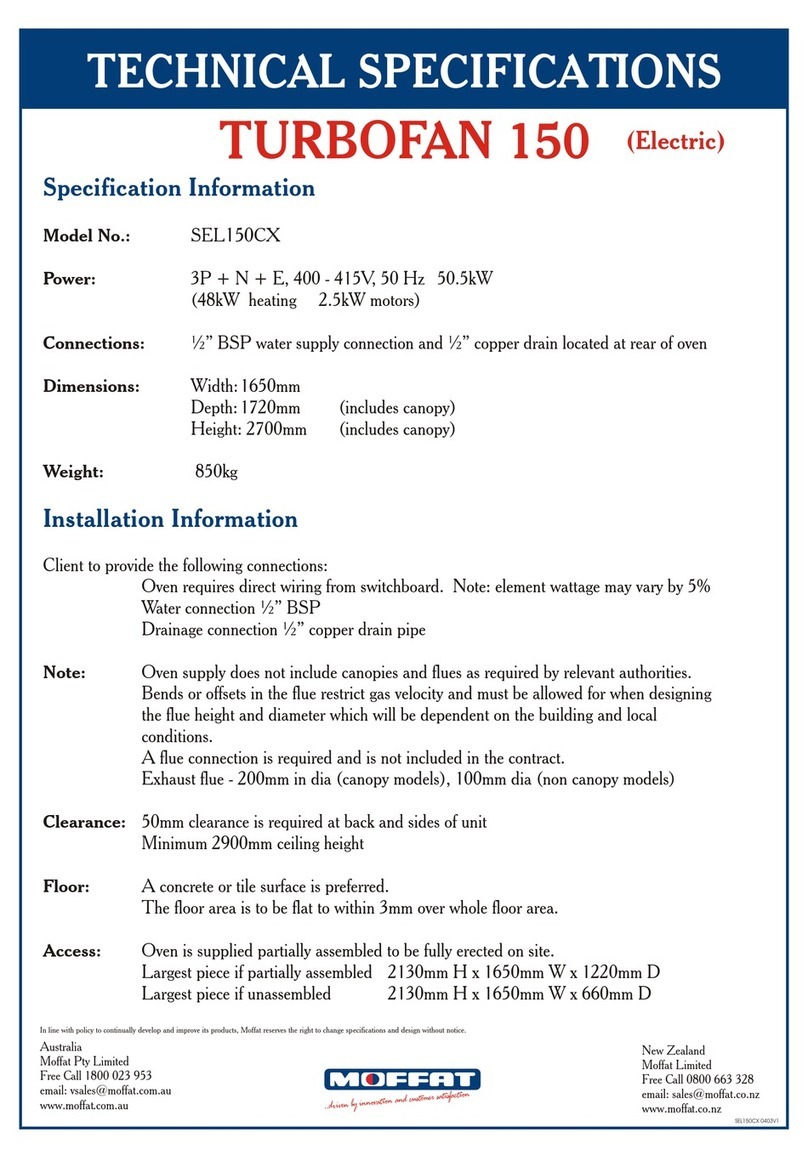
Moffat
Moffat Turbofan SEL150CX Technical specifications
